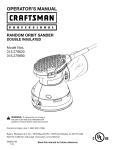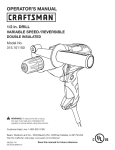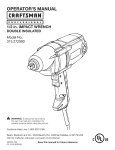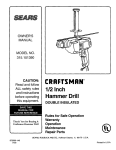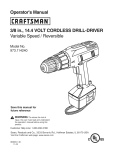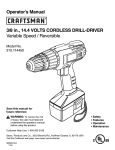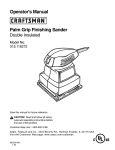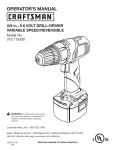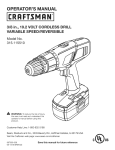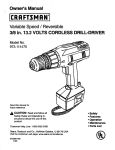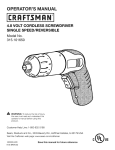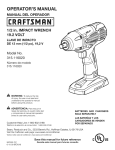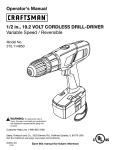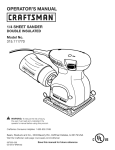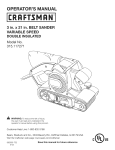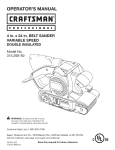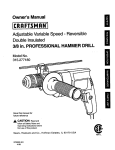Download Craftsman 315.265670 Operator`s manual
Transcript
PERATOR'S MANUAL ® 1/2 in. HAMMER DRILL VARIABLE SPEED/REVERSIBLE DOUBLE iNSULATED Model No. 315.265670 A WARNING: To reduce the risk of injury, the user must read and understand the operator's manual before using this product. Customer Help Line: 1=800=932=3188 Sears, Roebuck and Co., 3333 Beverly Rd., Hoffman Visit the Craftsman web page: www.sears.com/craftsman 983000-853 08-17-06 (REV:02) Save this manual Estates, IL 60179 USA for future reference [] Warranty............................................................................................................................................................ 2 [] Introduction ........................................................................................................................................................ 2 [] [] [] [] [] [] [] [] [] [] [] GeneralSafetyRules............................................................................................................................................ 3-4 SpecificSafetyRules............................................................................................................................................ 4 Symbols ............................................................................................................................................................. 5-6 Electrical ............................................................................................................................................................ 7 Features ............................................................................................................................................................. 8-9 Assembly ........................................................................................................................................................... 9 Operation ........................................................................................................................................................... 10-14 Maintenance ....................................................................................................................................................... 14-15 Accessories ........................................................................................................................................................ 15 Exploded ViewandPartsList.................................................................................................................................. 16 PartsOrdering/Service .................................................................................................................................... BackPage ONE-YEAR FULL WARRANTY ON CRAFTSMAN PROFESSIONAL TOOL If this Craftsman Professional tool fails to give complete satisfaction within one year from date of purchase, RETURN IT TO ANY SEARS STORE OR PARTS AND REPAIR CENTER OR OTHER CRAFTSMAN OUTLET iN THE UNITED STATES FOR FREE REPAIR. This warranty gives you specific legal rights, and you may also have other rights which vary from state to state. Sears, Roebuck and Co., Dept. 817WA, Hoffman Estates, IL 60179 This tool has many features for making its use more pleasant and enjoyable. Safety, performance, have been given top priority in the design of this product making it easy to maintain and operate. and dependability A WARNING! Read all instructions. Failure to follow all instructions listed below may result in electric shock, fire and/or serious injury. The term "power tool" in all of the warnings listed below refers to your mains-operated (corded) power tool or batteryoperated (cordless) power tool. SAVE THESE WORK INSTRUCTIONS AREA SAFETY [] Keep work area clean and well lit. Cluttered or dark areas invite accidents. [] Do not operate power tools in explosive atmospheres, such as in the presence of flammable liquids, gases or dust. Power tools create sparks which may ignite the dust or fumes. [] Keep children and bystanders away while operating a power tool. Distractions can cause you to lose control. ELECTRICAL SAFETY [] Power tool plugs must match the outlet. Never modify the plug in any way. Do not use any adapter plugs with earthed (grounded) power tools. Unmodified plugs and matching outlets will reduce risk of electric shock. [] Avoid body contact with earthed or grounded surfaces such as pipes, radiators, ranges and refrigerators. There is an increased risk of electric shock if your body is earthed or grounded. [] Do not expose power tools to rain or wet conditions. Water entering a power tool will increase the risk of electric shock. [] Do not abuse the cord. Never use the cord for carrying, pulling or unplugging the power tool. Keep cord away from heat, oil, sharp edges or moving parts. Damaged or entangled cords increase the risk of electric shock. [] When operating a power tool outdoors, use an extension cord suitable for outdoor use. Use of a cord suitable for outdoor use reduces the risk of electric shock. PERSONAL SAFETY [] Stay alert, watch what you are doing and use common sense when operating a power tool. Do not use a power tool while you are tired or under the influence of drugs, alcohol or medication. A moment of inattention while operating power tools may result in serious personal injury. [] Use safety equipment. Always wear Safety equipment such as dust mask, shoes, hard hat, or hearing protection priate conditions will reduce personal eye protection. non-skid safety used for approinjuries. [] Avoid accidental starting. Ensure the switch is in the off-position before plugging in. Carrying power tools with your finger on the switch or plugging in power tools that have the switch on invites accidents. [] Remove any adjusting key or wrench before turning the power tool on. A wrench or a key left attached to a rotating part of the power tool may result in personal injury. [] Do not overreach. Keep proper footing and balance at all times. This enables better control of the power tool in unexpected situations. [] Dress properly. Do not wear loose clothing or jewelry. Keep your hair, clothing and gloves away from moving parts. Loose clothes, jewelry or long hair can be caught in moving parts. [] if devices are provided for the connection of dust extraction and collection facilities, ensure these are connected and properly used. Use of these devices can reduce dust-related hazards. [] Do not wear loose clothing or jewelry. Contain long hair. Loose clothes, jewelry, or long hair can be drawn into air vents. [] Do not use on a ladder or unstable support. Stable footing on a solid surface enables better control of the power tool in unexpected situations. POWER TOOL USE AND CARE [] Do not force the power tool. Use the correct power tool for your application. The correct power tool will do the job better and safer at the rate for which it was designed. [] Do not use the power tool if the switch does not turn it on and off. Any power tool that cannot be controlled with the switch is dangerous and must be repaired. [] Disconnect the plug from the power source and/or the battery pack from the power tool before making any adjustments, changing accessories, or storing power tools. Such preventive safety measures reduce the risk of starting the power tool accidentally. [] Store idle power tools out of the reach of children and do not allow persons unfamiliar with the power tool or these instructions to operate the power tool. Power tools are dangerous in the hands of untrained users. [] Maintain power tools. Check for misalignment or binding of moving parts, breakage of parts and any other condition that may affect the power tool's operation. If damaged, have the power tool repaired before use. Many accidents are caused by poorly maintained power tools. [] Keep cutting tools sharp and clean. Properly maintained cutting tools with sharp cutting edges are less likely to bind and are easier to control. [] Use the power tool, accessories and tool bits etc., in accordance with these instructions and in the manner intended for the particular type of power tool, taking into account the working conditions and the work to be performed. Use of the power tool for operations different from those intended could result in a hazardous situation. SERVICE [] Have your power tool serviced by a qualified repair person using only identical replacement parts. This will ensure that the safety of the power tool is maintained. [] When servicing a power tool, use only identical replacement parts. Follow instructions in the Maintenance section of this manual. Use of unauthorized parts or failure to follow Maintenance instructions may create a risk of shock or injury. _1I_ WARNING! To reduce the risk of injury, user must read instruction manual. [] Wear ear protectors with impact noise can cause hearing loss. drills. Exposure to [] Use auxiliary handles supplied with the tool. Loss of control can cause personal injury. [] Hold power tools by insulated gripping surfaces when performing an operation where the cutting tool may contact hidden wiring or its own cord. Contact with a "live" wire will make exposed metal parts of the tool "live" and shock the operator. [] Know your power tool. Read operator's manual carefully. Learn its applications and limitations, as well as the specific potential hazards related to this tool. Following this rule will reduce the risk of electric shock, fire, or serious injury. [] Always wear safety glasses. Everyday eyeglasses have only impact-resistant lenses; they are NOT safety glasses. Following this rule will reduce the risk of serious personal injury. [] Protect your lungs. Wear a face or dust mask if the operation is dusty. Following this rule will reduce the risk of serious personal injury. [] Protect your hearing. Wear hearing protection during extended periods of operation. Following this rule will reduce the risk of serious personal injury. [] Inspect tool cords periodically and, if damaged, have repaired at your nearest Sears or other qualified service center. Constantly stay aware of cord location. Following this rule will reduce the risk of electric shock or fire. A [] Check damaged parts. Before further use of the tool, a guard or other part that is damaged should be carefully checked to determine that it will operate properly and perform its intended function. Check for alignment of moving parts, binding of moving parts, breakage of parts, mounting, and any other conditions that may affect its operation. A guard or other part that is damaged should be properly repaired or replaced by an authorized service center. Following this rule will reduce the risk of shock, fire, or serious injury. [] Make sure your extension cord is in good condition. When using an extension cord, be sure to use one heavy enough to carry the current your product will draw. A wire gauge size (A.W.G.) of at least 14 is recommended for an extension cord 50 feet or less in length. A cord exceeding 100 feet is not recommended. If in doubt, use the next heavier gauge. The smaller the gauge number, the heavier the cord. An undersized cord will cause a drop in line voltage resulting in loss of power and overheating. [] inspect for and remove all nails from lumber before using this tool. Following this rule will reduce the risk of serious personal injury. [] Save these instructions. Refer to them frequently and use them to instruct others who may use this tool. If you loan someone this tool, loan them these instructions also. WARNING: Some dust created by power sanding, sawing, grinding, drilling, and other construction activities contains chemicals known to cause cancer, birth defects or other reproductive harm. Some examples of these chemicals are: • lead from lead-based paints, crystalline silica from bricks and cement and other masonry products, and arsenic and chromium from chemically-treated lumber. Your risk from these exposures varies, depending on how often you do this type of work. To reduce your exposure to these chemicals: work in a well ventilated area, and work with approved safety equipment, such as those dust masks that are specially designed to filter out microscopic particles. Someofthefollowingsymbolsmaybeusedonthistool.Pleasestudythemandlearntheirmeaning.Properinterpretationofthesesymbolswillallowyouto operatethetoolbetterandsafer. SYMBOL NAME DESIGNATION/EXPLANATION V Volts Voltage A Amperes Current Hz Hertz Frequency (cycles per second) W Watt Power min Minutes Time "L, Alternating Current Type of current Direct Current Type or a characteristic of current n o No Load Speed Rotational speed, at no load [] Class II Construction Double-insulated .../min Per Minute Revolutions, strokes, surface speed, orbits etc., per minute @ Wet Conditions Alert Do not expose to rain or use in damp locations. Read The Operator's Manual To reduce the risk of injury, user must read and understand operator's manual before using this product. Eye Protection Always wear safety goggles or safety glasses with side shields, or a full face shield when operating this product. Safety Alert Precautions that involve your safety. No Hands Symbol Failure to keep your hands away from the blade will result in serious personal injury. No Hands Symbol Failure to keep your hands away from the blade will result in serious personal injury. No Hands Symbol Failure to keep your hands away from the blade will result in serious personal injury. No Hands Symbol Failure to keep your hands away from the blade will result in serious personal injury. Hot Surface To reduce the risk of injury or damage, avoid contact with any hot surface. 0 @ @ @ ® construction Thefollowingsignalwordsandmeanings areintendedto explainthe levelsofriskassociated withthis product. SYMBOL SIGNAL MEANING DANGER: Indicates an imminently hazardous situation, which, if not avoided, will result in death or serious injury. WARNING: Indicates a potentially hazardous situation, which, if not avoided, could result in death or serious injury. CAUTION: Indicates a potentially hazardous result in minor or moderate injury. situation, which, if not avoided, may CAUTION: (Without Safety Alert Symbol) Indicates a situation that may result in property damage. SERVICE Servicing requires extreme care and knowledge and should be performed only by a qualified service technician. For service we suggest you return the product to your nearest SEARS OR OTHER QUALIFIED SERVICE CENTER for repair. When servicing, use only identical replacement parts. _ A WARNING: To avoid serious personal injury, do not attempt to use this product until you read thoroughly and understand completely the operator's manual. Save this operator's manual and review frequently for continuing safe operation and instructing others who may use this product. WARNING: The operation of any power tool can result in foreign objects being thrown into your eyes, which can result in severe eye damage. Before beginning power tool operation, always wear safety goggles, safety glasses with side shields, or a full face shield when needed. We recommend Wide Vision Safety Mask for use over eyeglasses or standard safety glasses with side shields. Always use eye protection which is marked to comply with ANSI Z87.1. SAVE THESE INSTRUCTIONS DOUBLE INSULATION Double insulation is a concept in safety in electric power tools, which eliminates the need for the usual three-wire grounded power cord. All exposed metal parts are isolated from the internal metal motor components with protecting insulation. Double insulated tools do not need to be grounded. A WARNING: The double insulated system is intended to protect the user from shock resulting from a break in the tool's internal insulation. Observe all normal safety precautions to avoid electrical shock. NOTE: Servicing of a tool with double insulation requires extreme care and knowledge of the system and should be performed only by a qualified service technician. For service, we suggest you return the tool to your nearest Sears or other qualified service center for repair. Always use original factory replacement parts when servicing. ELECTRICAL CONNECTION This tool has a precision-built electric motor. It should be connected to a power supply that is 120 volts, 60 Hz, AO only (normal household current}. Do not operate this tool on direct current (DC). A substantial voltage drop will cause a loss of power and the motor will overheat. If the tool does not operate when plugged into an outlet, double-check the power supply. EXTENSION CORDS When using a power tool at a considerable distance from a power source, be sure to use an extension cord that has the capacity to handle the current the tool will draw. An undersized cord will cause a drop in line voltage, resulting in overheating and loss of power. Use the chart to determine the minimum wire size required in an extension cord. Only round jacketed cords listed by Underwriter's Laboratories (UL) should be used. When working outdoors with a tool, use an extension cord that is designed for outside use. This type of cord is designated with "WA" on the cord's jacket. Before using any extension cord, inspect it for loose or exposed wires and cut or worn insulation. **Ampere rating (on tool faceplate) 0-2.0 2.1-3.4 3.5-5.0 5.1-7.0 7.1-12.0 12.1-16.0 Cord Length Wire Size (A.W.G.) 25' 16 16 16 16 14 14 50' 16 16 16 14 14 12 100' 16 16 14 12 10 -- **Used on 12 gauge - 20 amp circuit NOTE: AWG = American Wire Gauge A A WARNING: Keep the extension cord clear of the working area. Position the cord so that it will not get caught on lumber, tools or other obstructions while you are working with a power tool. Failure to do so can result in serious personal injury. WARNING: Check extension cords before each use. If damaged replace immediately. Never use tool with a damaged cord since touching the damaged area could cause electrical shock resulting in serious injury. PRODUCTSPECIFICATIONS Chuck .......................................................... 1/2 in. Keyless Switch .......................................................................... No Load Speed ................................ VSR 0-1,000/O-2,700/min. Input ................................ 120 V, 60 Hz, AC only, 7.5 Amps Power Cord ................................................................ Net Weight ............................................................... 10 ft. 5.5 Ibs. Blows Per Minute ........................ 0-19,000/O-46,000/BPM LEVEL DRILLING/HAMMER MODESELECTOR TWO-SPEED GEARTRAIN (HI-LO) SPINDLELOCK BUTTON LOCK-ON BUTTON DIRECTIONOF ROTATIONSELECTOR (FORWARD/REVERSE) AUXILIARY HANDLEASSEMBLY KEYLESS CHUCK DEPTH GAUGECLAMP VARIABLESPEED SWITCHTRIGGER LIVE TOOL INDICATOR DEPTH STOPROD Fig. 1 KNOW YOUR HAMMER LEVEL DRILL See Figure 1. Before attempting to use this product, familiarize yourself with all operating features and safety rules. AUXILIARY HANDLE ASSEMBLY A level is located on the top of the motor housing to help you keep the drill bit level during use. LIVE TOOL INDICATOR Your drill is equipped with an auxiliary handle assembly for ease of operation and to prevent loss of control. The live tool indicator is located on the handle of the drill and indicates that the tool is connected to a power supply. BLOWS LOCK=ON PER MINUTE BUTTON This tool features an impact speed of 0-19,000/0-46,000 BPM (Blows Per Minute). Blows Per Minute is the number of impacts per minute. The lock-on button is convenient for continuous extended periods of time. DEPTH The spindle lock keeps the chuck from turning while installing and removing bits. STOP ROD A depth stop rod has been supplied with this product to assist in controlling the depth of drilled holes. DIRECTION OF ROTATION SELECTOR (FORWARD/REVERSE) Your drill has a direction of rotation (forward/reverse) selector located above the variable speed switch trigger for changing the direction of bit rotation. KEYLESS CHUCK The keyless chuck allows you to hand-tighten the drill bit in the chuck jaws. or release SPINDLE VARIABLE PACKING LiST Hammer Drill with Auxiliary Handle Assembly Depth Stop Rod Carrying Case Operator's Manual SPEED The variable speed switch trigger delivers higher speed with increased trigger pressure and lower speed with decreased trigger pressure. WARNING: If any parts are damaged or missing do not operate this tool until the parts are replaced. Failure to heed this warning could result in serious personal injury. A [] Do not discard the packing material until you have carefully inspected and satisfactorily operated the tool. [] If any parts are damaged or missing, please call 1-800-932-3188 for assistance. GEAR TRAIN The two-speed gear train is designed for drilling or driving at LO (1) or HI (2) speeds. A switch is located on the side of your drill for selecting either LO (1) or Hi (2) speed. This product has been shipped completely assembled. [] Inspect the tool carefully to make sure no breakage or damage occurred during shipping. LOCK TWO-SPEED UNPACKING [] Carefully remove the tool and any accessories from the box. Make sure that all items listed in the packing list are included. drilling for WARNING: Do not attempt to modify this tool or create accessories not recommended for use with this tool. Any such alteration or modification is misuse and could result in a hazardous condition leading to possible serious personal injury. A WARNING: Do not connect to power supply until assembly is complete. Failure to comply could result in accidental starting and possible serious injury. A WARNING: Do not allow familiarity with tools to make you careless. Remember that a careless fraction of a second is sufficient to inflict serious REVERSE injury. A WARNING: Always wear safety goggles or safety glasses with side shields when operating power tools. Failure to do so could result in objects being thrown into your eyes resulting in possible serious injury. SWITCH TRIGGER FORWARD / DIRECTIONOF ROTATIONSELECTOR (FORWARD/REVERSE) APPLiCATiONS You may use this tool for the purposes listed below: [] Hammer drilling in concrete, brick, or other masonry [] Drilling in wood Fig. 2 [] Drilling in ceramics, plastics, fiberglass, and laminates KEYLESS [] Drilling in metals [] Mixing paint VARIABLE SPEED SWITCH The drill has a keyless chuck that makes it simple to tighten or release drill bits in the chuck jaws. The arrows on the chuck indicate which direction to rotate the chuck body in order to LOCK (tighten) or UNLOCK (release) the drill bit. TRIGGER See Figure 2. To turn the drill ON, depress the variable speed switch trigger. To turn it OFF, release the variable speed switch trigger. VARIABLE A SPEED The variable speed switch delivers higher speed and torque with increased trigger pressure and lower speed with decreased trigger pressure. NOTE: You might hear a whistling or ringing noise from the switch during use. Do not be concerned; this is a normal part of the switch function. DiRECTiON CHUCK See Figure 3. OF ROTATION WARNING; Do not hold the chuck body with one hand and use the power of the drill to tighten the chuck jaws on the drill bit. The chuck body could slip in your hand, or your hand could slip and come in contact with the rotating drill bit. This could cause an accident resulting in serious personal injury. UNLOCK (RELEASE) SELECTOR CHUCKJAWS CHUCK BODY (FORWARD/REVERSE} See Figure 2. The direction of bit rotation is reversible and is controlled by a selector located above the switch trigger. With the drill held in normal operating position, the direction of rotation selector should be positioned to the left of the switch trigger for forward drilling. The drilling direction is reversed when the selector is to the right of the switch trigger. DRILLBIT CAUTION: To prevent gear damage, always allow the chuck to come to a complete stop before changing the direction of rotation. LOCK (TIGHTEN) To stop the drill, release the variable speed switch trigger and allow the chuck to come to a complete stop. NOTE: The drill will not run unless the direction of rotation selector is pushed fully to the left or right. Avoid running the drill at low speeds for extended periods of time. Running at low speeds under constant usage may cause the drill to become overheated. If this occurs, cool the drill by running it without a load and at full speed. SPINDLE LOCKBUTTON Fig. 3 10 SPINDLELOCK TW0-SPEED GEARTRAIN(Hi-LO) See Figure 3. 2-HI SPEED [] To lock the spindle, depress and hold the spindle lock button. [] While keeping the button depressed, rotate the chuck clockwise until the spindle clicks into a locked position and will not rotate further. ) [] To unlock, release the button. NOTE: Always be sure the spindle lock button is released and disengaged before turning the drill ON. TWO-SPEED See Figure 4. GEAR TRAIN The drill has a two-speed gear train designed for drilling or driving at LO (1) or HI (2} speeds. A switch is located on the side of the drill to select either LO (1) or HI (2) speed. When using drill in the LO (1) speed range, speed will decrease and unit will have more power and torque. When using drill in the HI (2) speed range, speed will increase and unit will have less power and torque. Use LO (1) speed for high power and torque applications and HI (2) speed for fast drilling or driving applications. _IIL WARNING: 1-LO SPEED Fig. 4 UNLOCK (RELEASE) CHUCKJAWS CHUCK BODY Always unplug the tool when installing or removing bits, adjusting settings, or when the tool is not in use. Failure to unplug the tool may result in accidental starting and serious personal injury. INSTALLING BITS DRILLBIT See Figure 5 - 6. [] Unplug the drill. LOCK (TIGHTEN) [] Lock the spindle. [] Open or close the chuck opening is slightly larger use. Also, raise the front bit from falling out of the Insert the drill bit. jaws to a point where the than the bit size you intend to of the drill slightly to keep the chuck jaws. SPINDLE LOCKBUTTON RIGHT Fig. 5 WARNING: Make sure to insert the drill bit straight into the chuck jaws. Do not insert the drill bit into the chuck jaws at an angle then tighten, as shown in figure 6. This could cause the drill bit to be thrown from the drill, resulting in possible serious personal injury or damage to the chuck. [] Tighten the chuck jaws securely on the bit. NOTE: Rotate the chuck body in the direction of the arrow marked LOCK to close the chuck jaws. Do not use a wrench to tighten or loosen the chuck jaws. [] Release the spindle lock button. Fig. 6 11 REMOVINGBITS NOTE: For convenience and ease of starting threads, the hex nut has been trapped inside the molded slot in the handle assembly. See Figure 5, [] Unplug the drill. The depth stop rod helps control the depth of drilled holes. [] Lock the spindle. [] Open the chuck jaws. NOTE: When properly installed, the teeth on the depth stop rod should be aligned with the teeth indicator on the depth stop clamp. NOTE: Rotate the chuck body in the direction of the arrow marked UNLOCK to open the chuck jaws. Do not use a wrench to tighten or close the chuck jaws. [] Remove the drill bit. Adjust the depth stop rod so that the drill bit extends beyond the end of the rod to the required drilling depth. [] Release the spindle lock button. USING THE AUXILIARY HANDLE When drilling holes with the depth stop rod installed, the desired hole depth has been reached when the end of the rod comes in contact with the surface of the workpiece. ASSEMBLY See Figure 7. An auxiliary handle assembly is packed with the drill for ease of operation and to help prevent loss of control. The handle can be rotated 360 ° , and it can also be mounted on the opposite side for left hand use. SELECTING [] Rotate the handle assembly to the desired operating position. NOTE: The hammer drill has not been designed for reverse hammering. [] Securely tighten by turning the handle assembly clockwise. Use carbide-tipped bits and select hammer mode when drilling in hard materials such as brick, tile, concrete, etc. Be sure the handle assembly is securely tightened against the depth stop clamp. This secures the depth stop rod at the desired depth of cut. It also secures the handle assembly. DRILL BIT DRILLINGDEPTH OR DRILLING See Figure 8, [] Loosen the handle assembly by turning the handle counterclockwise. DRILLING DEPTH MODE To adjust for type of drilling, slide the drilling mode selector on top of the motor housing to hammer mode or drilling mode. The hammer mode symbol is on the left and the drill bit symbol is on the right. To adjust the auxiliary handle assembly, TO DECREASE DRiLLiNGDEPTH TOINCREASE HAMMER MODE Select normal drill mode when drilling with twist drills, hole saws, etc., in soft materials. DRILLING/ HAMMERMODESELECTOR DRILLINGMODE DEPTH STOPROD TO LOOSENAUXiLiARY HANDLEASSEMBLY AND CLAMP LOCK-ON BUTTON Fig. 7 Fig. 8 12 ENDViEW LOCK-ON BUTTON See Figure 8, This drill is equipped with a lock-on feature, which is convenient for continuous drilling for extended periods of time. To lock-on: LEVEL [] Depress the variable speed switch trigger. [] Push in and hold the lock-on button, located on the side of the handle. [] Release the variable speed switch trigger. [] Release the lock-on button and the drill will continue running. [] To release the lock, depress and release the variable speed switch trigger. If the lock-on feature is engaged during use and the drill becomes disconnected from the power supply, disengage the lock-on feature immediately. _1_ WARNING: Before connecting the drill to a power supply source, always check to be sure it is not in lock-on position (depress and release the variable speed switch trigger). Failure to ensure that it is not locked-on could result in accidental starting of the drill resulting in possible serious injury. Do not lock the variable speed switch trigger in applications where the drill may need to be suddenly stopped. DRILLING See Figure 9. A level is located on top of the motor housing to help keep the drill bit level during use. [] Depress and release the variable speed variable speed switch trigger to be sure the drill is in the OFF position before connecting it to a power supply. [] Check the direction of rotation selector for the correct setting (forward or reverse). [] Secure the material to be drilled in a vise or with Fig. 9 clamps to keep it from turning as the drill bit rotates. [] When drilling hard, smooth surfaces, use a center punch to mark the desired hole location. This will prevent the drill bit from slipping off-center as the hole is started. [] Plug the drill into power supply. Hold the drill firmly and place the bit at the point to be drilled. [] Depress the variable speed switch trigger to start the drill. [] When drilling metals, use a light oil on the drill bit to keep it from overheating. The oil will prolong the life of the bit and increase the drilling action. [] Move the drill bit into the workpiece, applying only enough pressure to keep the bit cutting. Do not force the drill or apply side pressure to elongate a hole. Let the tool do the work. A [] If the bit jams in the workpiece or if the drill stalls, stop the tool immediately. Remove the bit from the workpiece and determine the reason for jamming. WARNING: Be prepared for binding at bit breakthrough. When these situations occur, the drill has a tendency to grab and kick in the opposite direction and could cause loss of control when breaking through material. If not prepared, this loss of control can result in possible serious injury. 13 WOOD DRILLING • Overheat the drill; For maximum performance, use high speed steel bits for wood drilling. Wear the bearings; [] Select normal drilling mode. Produce off-center or irregular-shaped Bend or burn bits; and holes. [] Begin drilling at a very low speed to prevent the bit from slipping off the starting point. Increase the speed as the drill bit bites into the material. [] When drilling large holes in metal, start with a small bit, then finish with a larger bit. Also, lubricate the bit with oil to improve drilling action and increase bit life. [] When drilling through holes, place a block of wood behind the workpiece to prevent ragged or splintered edges on the back side of the hole. MASONRY METAL DRILLING For maximum performance, use carbide-tipped masonry impact bits when drilling holes in brick, tile, concrete, etc. DRILLING [] Slide adjustment button on hammer drill left for hammer mode. For maximum performance, use high speed steel bits for metal or steel drilling. [] Select normal drilling mode. [] Apply light pressure and medium speed for best results in brick. [] Begin drilling at a very low speed to prevent the bit from slipping off the starting point. [] Apply additional pressure for hard materials such as concrete. [] Maintain a speed and pressure which allows cutting without overheating the bit. Applying too much pressure will: [] When drilling holes in tile, practice on a scrap piece to determine the best speed and pressure. Begin drilling at a very low speed to prevent the bit from slipping off the starting point. A Electric tools used on fiberglass material, wallboard, spackling compounds, or plaster are subject to accelerated wear and possible premature failure because the fiberglass chips and grindings are highly abrasive to bearings, brushes, commutators, etc. Consequently, we do not recommended using this tool for extended work on these types of materials. However, if you do work with any of these materials, it is extremely important to clean the tool using compressed air. A WARNING: When servicing, use only identical Craftsman replacement parts. Use of any other parts may create a hazard or cause product damage. WARNING: Always wear safety goggles or safety glasses with side shields during power tool operation or when blowing dust. If operation is dusty, also wear a dust mask. GENERAL LUBRICATION MAINTENANCE All of the bearings in this tool are lubricated with a sufficient amount of high grade lubricant for the life of the unit under normal operating conditions. Therefore, no further lubrication is required. Avoid using solvents when cleaning plastic parts. Most plastics are susceptible to damage from various types of commercial solvents and may be damaged by their use. Use clean cloths to remove dirt, dust, oil, grease, etc. ,_ WARNING: Only the parts shown on the parts list are intended to be repaired or replaced by the customer. All other parts should be replaced at a Sears Service Center. Do not at any time let brake fluids, gasoline, petroleum-based products, penetrating oils, etc., come in contact with plastic parts. Chemicals can damage, weaken or destroy plastic which may result in serious personal injury. 14 CHUCK REMOVAL See Figures 10- 12. MALLET The chuck may be removed and replaced with a new one. [] Unplug the drill. [] Insert a 5/16 in. or larger hex key into the chuck of the drill and tighten the chuck jaws securely. [] Tap the hex key sharply with a mallet in a clockwise direction. This will loosen the screw in the chuck for easy removal. MALLET CHUCKJAWS REXKEY Fig. 12 [] Insert the hex key into the chuck and tighten the chuck jaws securely. Tap sharply with a mallet in a counterclockwise direction. This will loosen the chuck on the spindle. It can now be unscrewed by hand. TO RETIGHTEN HEXKEY [] A LOOSE CHUCK The chuck may become loose on the spindle and develop a wobble. Also, the chuck screw may become loose, causing the chuck jaws to bind and prevent them from closing. To tighten: Open the chuck jaws and remove the hex key. Using a screwdriver, remove the chuck screw by turning it in a clockwise direction. [] Unplug the drill. NOTE: The chuck screw has left hand threads. [] Open the chuck jaws. SCREWDRIVER [] Insert a hex key into the chuck and tighten chuck jaws securely. Tap the hex key sharply with a mallet in a clockwise direction. This will tighten the chuck on the spindle. J [] Open the chuck jaws and remove the hex key. [] Tighten the chuck screw. Fig. 11 A Look for these accessories at Sears retail: [] High Speed Bits (For wood or metal) (1/2 in. max.) [] Wood Boring Bits (1 in. max.) [] Hole Saws (2 in. max.) [] Masonry Bits (3/4 in. max.) [] Doweling Jig [] Drill Stand [] Wire Brushes, All 15 WARNING" Current attachments and accessories available for use with this tool are listed above. Do not use any attachments or accessories not recommended by the manufacturer of this tool. The use of attachments or accessories not recommended can result in serious personal injury. CRAFTSMAN DRILL _" PROFESSIONAL MODEL NUMBER 1/2 in. HAMMER 315.265670 J The number model in all number correspondence will be foundregarding on a plate your attached HAMMER to the DRILL motoror housing. when ordering Always repair mention parts, the model SEE BACK PAGE FOR PARTS ORDERING "! INSTRUCTIONS 2 1 4 SEENOTE 6 PARTS LIST Key No. PaN Number Description 1 6613402 Screw .............................................................................................................. 1 2 690033076 Chuck .............................................................................................................. 1 3 940057066 Data Plate ........................................................................................................ 1 4 940304178 Logo Plate ....................................................................................................... 1 5 300188034 Auxiliary Handle Assembly .............................................................................. 1 6 631471001 Depth Stop Rod .............................................................................................. 1 983000853 Operator's Note: Qty. Manual The assembly shown represents an important part of the double insulated system. To avoid the possibility of alteration or damage to the system, service should be performed by your nearest Sears repair center. Contact your nearest Sears retail store for service center information. * Standard Hardware Item = May Be Purchased Locally ** Available From Div. 98 - Source 980.0 16
















